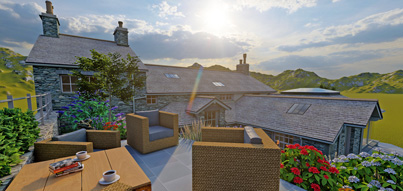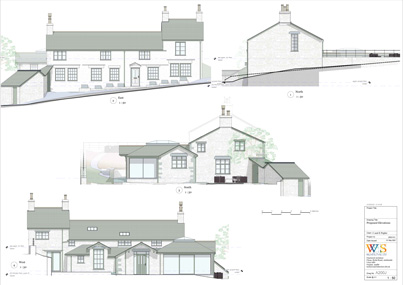Architect Spotting
To call yourself an Architect in the UK you must be registered with the ARB - the title is protected by Act of Parliament
Supposedly spot an Architect in the street as the one person looking up while walking along (some truth in this)
Architect protected


Architects
The National Park is increasingly one large village. A strong rural character is still present in the long-term residents. If you buy a property in the area you have to accept that most local people will know a lot about you if not within days then certainly within the first few weeks. It is a good thing in many ways as even the most famous residents don't get bothered which is possibly part of the reason they come.
There is a tradition of personal recommendation which still thrives. Whether you are looking for an Architect or a chimney sweep asking around will usually produce honest opinions.
To my mind this is a sensible approach.
Nearly all my work comes from recommendation - but that probably reflects the rural location.
Websites are a good tool. I find that clients often use my site as a reference check before getting in touch to have an initial chat.
Commercial Listings and Directories
Choosing any firm out of such as Yellow Pages is a bit of a lottery and long ago I removed my Yellow Pages advertisement however I do know that some colleagues get work from advertising in YP and/or yell.com.
There are a number of online listings of Architects of generally poor quality and often include non-Architects (see Architects Registration Board (ARB) in next section).

Royal Institutes - what's that all about?
RIBA
Many, but by no means all, UK Architects are members of the RIBA (Royal Institute of British Architects) and affiliated home nations' Institutes RIAS, RSAW and RSUA.
Membership allows Architects to call themselves 'Chartered' and have the letters 'RIBA' after their name. I am a member of the RIBA and also of the RIAS (see below)
The RIBA maintains online databases of members and Practices however it only promotes Practices and excludes from listing or promotion the many Practices who do not subscribe to its 'Chartered Practice' scheme. I once subscribed to this but eventually decided it was aimed at promoting larger practices.
RIAS
The RIAS is the Scottish equivalent of the RIBA and they have longstanding agreements to work together.
Although long based in Ambleside I am a member, being born in Scotland (Inverness), studying Architecture at Edinburgh University and working in Scotland before I moved to a Practice here many years ago.
Also working close to the border it helps to understand what is going on in Scotland.
Architects Registration Board
The ARB
The title 'Architect' is protected under UK law and every architect practicing in the UK must be registered with the Architects Registration Board (ARB).
Notwithstanding the proliferation in recent years of such titles as Software Architect, Landscape Architect, Interior Architect, Architectural Designer, Building Designer etc. etc. the title Architect is limited to those Registered with the ARB.
The ARB has a rather good web site with quick search facility and unlike the Royal Institutes' directories includes every architect Registered in the UK.
Complaints Procedures
All of the above organisations have Codes of Conduct for members and offer complaint and dispute resolution guidance and procedures linked via their websites (some more prominent than others - here are the links)
The Codes of Conduct require that I have my own disputes procedure in place. Thus in the first instance if any Client feels they have a complaint (or even a 'minor grumble') they need to let me know as soon as possible so that it can be addressed promptly. The goodwill and confidence of Clients is of prime importance and maintaining good relations and communication is vital to every project.
In my case telephone or email usually and we have an informal chat. It doesn't need to be about an imminent job I will answer any query as best I can. Social media is also fine - links are at the top left of this page.
Within reasonable distance I don't mind meeting up for a no-obligation chat on site. If this goes well then I will send a fee proposal. If that is acceptable then I can organise measuring up or further research and get things under way.
There isn't a standard pattern to be honest - every job is different and I try to be as flexible and accommodating as I can.
Stages in a project
Summary
Broadly speaking the headings below are a reasonable summary of how jobs proceed although every job is different and I doubt if I have ever seen one which went exactly as the list, but it is a useful read.
On some projects stages are 'telescoped' by clients eager to get work under way immediately after planning consent and on many jobs now detail design is a rolling programme. I tend to work on these types of job with a team of trusted contractors who can handle the demands of such a process and still produce very high quality workmanship.
The RIBA (see left) famously produces a 'Plan of Work' document with nicely set out stages and procedures but while an interesting reference work I have never seen it used directly in a project but worth a look via the link
- Initial contact, follow up meeting for informal discussion
- Agree terms (I send you a fee estimate) See Charges page
- Do measured survey (I now recommend a local firm of land surveyors to quote for the measured survey)
- Draw/model up the existing layout
- Draw/model up a design
- Discuss with client and amend (repeat as necessary)
- Make any Planning Applications on client's behalf
- Wait for Planning Consent or resolve any issues, if possible
- Draw up detail plans to allow builder to price and to
- Make Building Regulations application
- Agree choice of contractor(s) with client
- If appointed to run the job arrange for formal acceptance of prices and start of work on site.
- If appointed to do so carry out periodic inspections of the work
- Sort out any problems that arise during the works
- If appointed to do so certify contractor's claims for payment and agree final account.
While this is a simplification it just about covers the usual order of events in a typical project. Below is a bit more detail:
Working on a typical project

My usual work environment but adjusted here for an imminent client meeting (pre-pandemic) as the left monitor with the building walk-through is set slightly back on the desk top.
From the model to rendered output
The Autodesk Revit building model produces the drawings semi-automatically and also updates them in real time. For client presentations I link the model into real-time rendering software (i.e. using a computer screen and 'spacemouse' to wander around inside the virtual building)
Despite all the technology employed routinely I like my drawings to still look like drawings. There should be an example linked below the picture underneath this paragraph.

Design work in progress - proposals for a house extension above in Little Langdale - rendered computer model

Site Map
|
Planning Maze
|
|
Trade Gadgets
CDM2015
|
|


William Sutherland rias riba
Chartered Architect
Director
Cluan, Rydal Road, Ambleside LA22 9BA
Tel: 015394 34489






